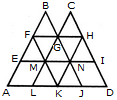Discussion
Home ‣ Non Verbal Reasoning ‣ Cubes and Dice See What Others Are Saying!
- Question
How many dots lie opposite to the face having three dots, when the given figure is folded to form a cube?

Options- A. 2
- B. 4
- C. 5
- D. 6
- Correct Answer
- 6
ExplanationThe given figure is similar to Form V. Therefore, when this figure is folded to form a cube then the face bearing six dots will lie opposite the face bearing three dots. - 1. Find the number of triangles in the given figure.

Options- A. 16
- B. 18
- C. 14
- D. 15 Discuss
- 2. Which one of the answer figures shall complete the given question figure?
Options- A. 1
- B. 2
- C. 3
- D. 4 Discuss
- 3. Select a figure from amongst the Answer Figures which will continue the same series as established by the five Problem Figures.
Problem Figures: Answer Figures:
 (A) (B) (C) (D) (E) (1) (2) (3) (4) (5)
(A) (B) (C) (D) (E) (1) (2) (3) (4) (5)
Options- A. 1
- B. 2
- C. 3
- D. 4
- E. 5 Discuss
- 4. How many circles are there in the adjoining figure.

Options- A. 11
- B. 12
- C. 13
- D. 14 Discuss
- 5. Which one of the answer figures shall complete the given question figure?
Options- A. 1
- B. 2
- C. 3
- D. 4 Discuss
- 6. Select the one which is different from the other three responses
Options- A. 1
- B. 2
- C. 3
- D. 4 Discuss
- 7. A piece of paper is folded and punched as shown below. From the given responses indicate how it will appear when opened.
Options- A. 1
- B. 2
- C. 3
- D. 4 Discuss
- 8. Choose the correct water image of the given figure (X) from amongst the four alternatives.

Options- A. 1
- B. 2
- C. 3
- D. 4 Discuss
- 9. Which of the answer figure is exactly the mirror image of the given figure, when the mirror is held on the line AB?
Options- A. 1
- B. 2
- C. 3
- D. 4 Discuss
- 10. NEXA
Options- A. .
- B. .
- C. .
- D. . Discuss
More questions
Correct Answer: 18
Explanation:

The simplest triangles are BFG, CGH, EFM, FMG, GMN, GHN, HNI, LMK, MNK and KNJ i.e. 10 in number.
The triangles composed of three components each are FAK and HKD i.e. 2 in number.
The triangles composed of four components each are BEN, CMI, GLJ and FHK i.e. 4 in number.
The triangles composed of eight components each are BAJ and OLD i.e. 2 in number.
Thus, there are 10 + 2 + 4 + 2 = 18 triangles in the given figure.
Correct Answer: 4
Explanation:
NA
Correct Answer: 5
Explanation:
Correct Answer: 13
Explanation:

There are 13 circles in the given figure. This is clear from the adjoining figure in which the centres of all the circles in the given figure have been numbered from 1 to 13.
Correct Answer: 2
Explanation:
NA
Correct Answer: 1
Explanation:
Except in figure (1), in all other figures there is one type of lining. In figure (1) there are both vertical and horizontal lines.
Correct Answer: 1
Explanation:
NA
Correct Answer: 2
Correct Answer: 4
Explanation:
According to given question figure ,
we can say that the mirror image always be opposite the original image across the given line. Given image will become opposite in mirror across the given line AB.As shown in given below .
Correct Answer: .
Explanation:
Answer A
Comments
There are no comments.Programming
Copyright ©CuriousTab. All rights reserved.
